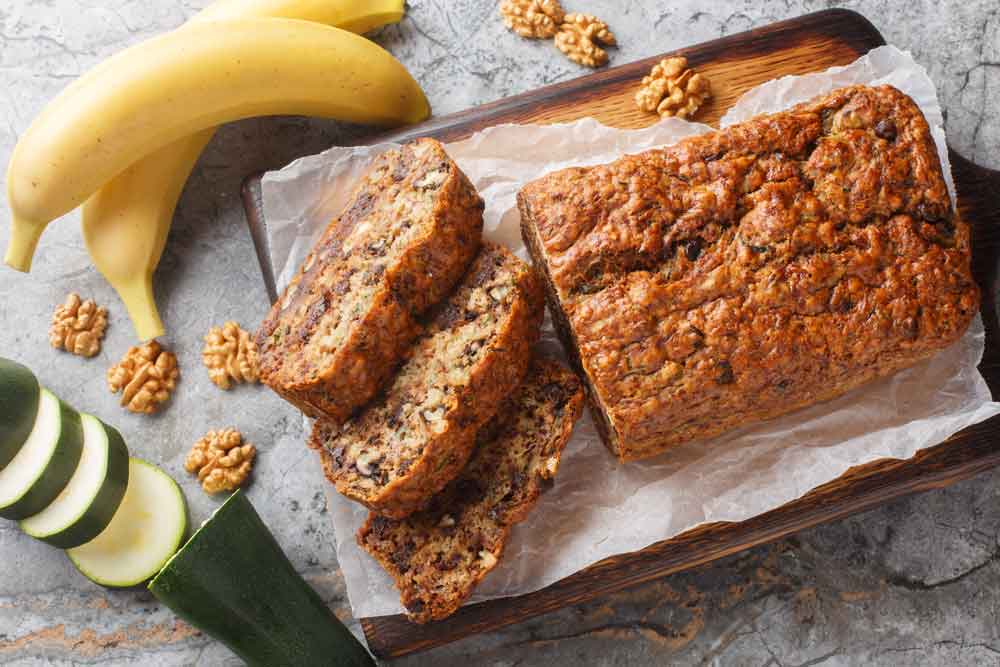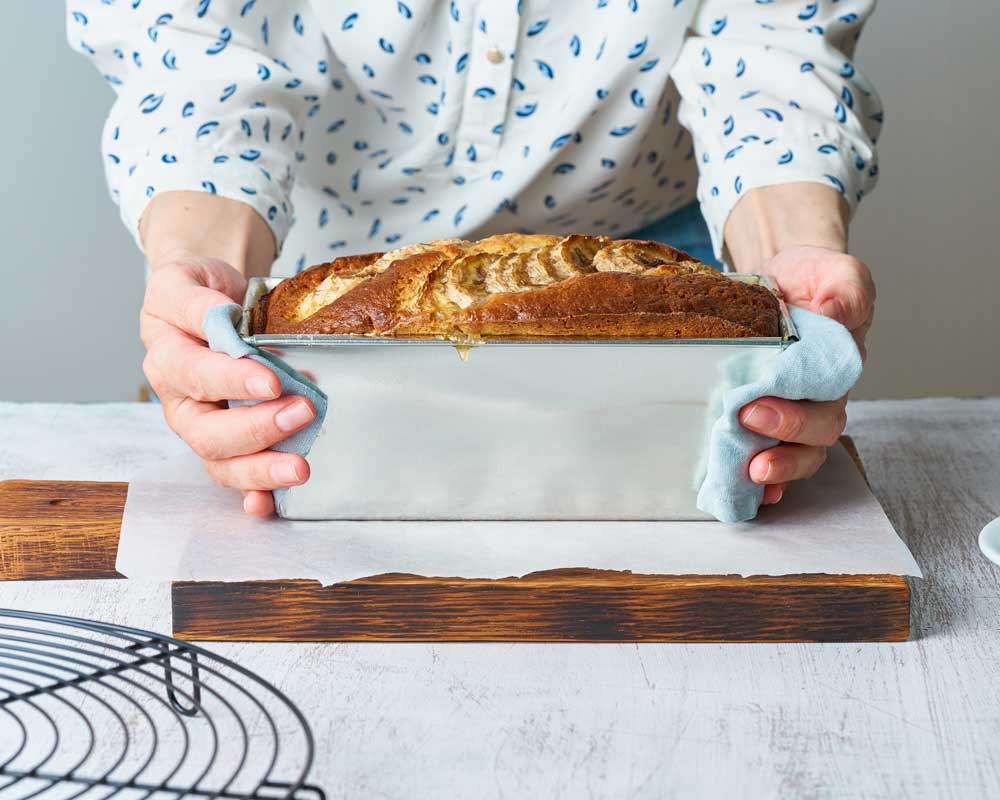Banana bread is more than just a baked good; it's a nostalgic comfort food. Originating in the U.S. during the Great Depression of the 1930s, it was created as a way to use up overripe bananas instead of discarding them. Home bakers mashed the bananas and mixed them into a simple loaf, resulting in a moist, sweet treat. This not only reduced waste but also offered a delicious new way to enjoy bananas.
Early recipes were basic, combining baking soda, flour, sugar, and mashed bananas. Over time, variations have emerged, adding nuts, chocolate chips, and spices. Today, banana bread remains a beloved staple, cherished for its rich flavor and comforting texture. Whether enjoyed fresh from the oven or toasted with butter, it holds a special place in both traditional and modern kitchens.
Ingredients Required to Make Banana Bread
To make a classic banana bread that is moist and full of flavor, you'll need the following ingredients:
● Bananas: 3 to 4 ripe bananas. The bananas should be overripe, with lots of black spots or even some black skin. Overripe bananas are sweeter and softer, making them ideal for baking banana bread.
● Flour: 1 ½ cups of all-purpose flour. Make sure the flour is sifted to avoid lumps and ensure even mixing with other ingredients.
● Sugar: 1 cup of granulated sugar. For a richer flavor, you can substitute granulated sugar with brown sugar, which adds a deeper caramel-like taste.
● Butter: ⅓ cup of unsalted butter, melted. Unsalted butter is preferred to control the amount of salt in the recipe. If you want a dairy-free option, you can substitute with coconut oil.
● Eggs: 2 large eggs, beaten. Eggs act as a binding agent and help the bread rise. For egg-free alternatives, consider using flax eggs or applesauce.
● Baking Soda: 1 teaspoon. This ingredient helps the bread rise and become fluffy. Ensure it’s fresh for optimal results.
● Salt: ¼ teaspoon. Salt enhances the overall flavor of the banana bread and balances the sweetness.
● Vanilla Extract: 1 teaspoon. Vanilla adds a subtle depth of flavor and complements the sweetness of the bananas.
● Optional Add-ins: ½ cup of nuts (such as walnuts or pecans) or chocolate chips. These optional ingredients can add texture and flavor to your banana bread.

Step-by-Step Recipe to Bake Banana Bread
1. Preheat Your Oven: Begin by preheating your oven to 350°F (175°C). Preheating is crucial as it ensures that the banana bread bakes evenly and rises properly. Grease a 9x5-inch loaf pan with butter or non-stick spray, or line it with parchment paper to prevent sticking.
2. Prepare the Bananas: In a large mixing bowl, mash the bananas with a fork until smooth. If you prefer some chunks of banana in your bread, you can mash them less. The bananas should be very ripe, as their natural sweetness and softness are key to a great banana bread.
3. Combine Wet Ingredients: In a separate bowl, whisk together the melted butter and sugar until well combined. This mixture should be creamy and slightly glossy. Add the beaten eggs and vanilla extract, continuing to mix until everything is fully integrated.
4. Mix Dry Ingredients: In another bowl, sift together the flour, baking soda, and salt. Sifting ensures that the baking soda and salt are evenly distributed throughout the flour, which helps in achieving a uniform texture and rise in the bread.
5. Combine Wet and Dry Ingredients: Gradually add the dry ingredients to the wet ingredients, mixing gently. It's important not to overmix the batter, as this can lead to dense banana bread. Mix just until the flour is incorporated into the batter, and you no longer see streaks of flour.
6. Fold in Bananas: Gently fold the mashed bananas into the batter. If you’re adding nuts or chocolate chips, fold them in at this stage. Be careful not to overmix, as this can also affect the texture of your bread.
7. Pour and Bake: Pour the batter into the prepared loaf pan, spreading it evenly. Bake in the preheated oven for 60-70 minutes. Baking times can vary based on your oven and the specific pan you use, so start checking for doneness at 60 minutes. Insert a toothpick or skewer into the center of the loaf; it should come out clean or with a few moist crumbs.
8. Cool and Serve: Once baked, allow the banana bread to cool in the pan for about 10 minutes. This makes it easier to remove from the pan without falling apart. After cooling slightly, transfer it to a wire rack to cool completely before slicing. Enjoy your banana bread as is, or with a spread of butter or cream cheese.
Substitutes That Can Be Used
If you need to make substitutions in your banana bread recipe, there are several options that can still yield delicious results:
● Flour: For a healthier option, you can use whole wheat flour instead of all-purpose flour. Whole wheat flour adds a nuttier flavor and a denser texture. Gluten-free flour blends can also be used for those with gluten sensitivities. However, gluten-free flour may alter the texture of the bread, so you might need to adjust the amount of liquid or other ingredients.
● Sugar: If you prefer a less refined sugar, try using honey, maple syrup, or coconut sugar. These alternatives provide a different flavor profile and can slightly affect the texture of the bread. Honey and maple syrup add moisture, so you might need to reduce other liquid ingredients slightly.
● Butter: Substitute unsalted butter with coconut oil for a dairy-free version, or use Greek yogurt for a lower-fat option. Greek yogurt can add extra moisture and a slight tang to the bread.
● Eggs: For a vegan version, flax eggs or chia eggs can replace the eggs. To make a flax egg, mix 1 tablespoon of flaxseed meal with 3 tablespoons of water and let it sit for a few minutes to thicken. Applesauce can also be used, with ¼ cup replacing each egg.
Can Frozen Bananas Be Used to Make Banana Bread?
Frozen bananas are an excellent choice for banana bread and can sometimes be even better than fresh bananas. Freezing bananas concentrates their sweetness and makes them extremely soft, which is perfect for baking. Here’s how to use frozen bananas in your recipe:
1. Thaw the Bananas: Remove the bananas from the freezer and allow them to thaw at room temperature. This usually takes a few hours. If you're in a hurry, you can microwave them for 30-60 seconds. If there’s excess liquid after thawing, drain it before mashing.
2. Mash and Use: Once thawed, mash the bananas as you would fresh ones. They may be a bit more watery, but this is normal and won’t affect the outcome of your banana bread as long as you drain any excess liquid.
How to Freeze Banana Bread
Freezing banana bread is a great way to keep it fresh for longer and ensures you always have a delicious treat on hand. Here’s a step-by-step guide:
1. Cool Completely: Allow the banana bread to cool completely after baking. This step prevents condensation from forming inside the wrapping, which can lead to soggy bread.
2. Wrap Properly: Wrap the cooled loaf tightly in plastic wrap or aluminum foil. For added protection, place the wrapped loaf in a resealable freezer bag or airtight container.
3. Label and Freeze: Label the bag or container with the date to keep track of how long it’s been in the freezer. Banana bread can be frozen for up to 3 months without a significant loss in quality.
4. Thawing: To thaw, remove the bread from the freezer and let it sit at room temperature for several hours or overnight. For a quicker method, you can use the microwave or oven to reheat the bread. If using the oven, wrap it in foil and heat at 350°F (175°C) for about 10-15 minutes.
Tips to Bake a Perfect Banana Bread
1. Use Overripe Bananas: The key to a flavorful banana bread is using very ripe bananas. They should be soft and have a lot of brown spots or black skin. These bananas are sweeter and will result in a moister bread.
2. Avoid Overmixing: When combining the wet and dry ingredients, mix just until combined. Overmixing can develop the gluten in the flour and lead to a dense, tough loaf.
3. Check for Doneness Early: Start checking the banana bread for doneness at 60 minutes. Every oven is different, and it’s better to check early to prevent overbaking. The bread is done when a toothpick inserted into the center comes out clean or with a few moist crumbs.
4. Add-ins for Variety: Feel free to experiment with different add-ins like nuts, chocolate chips, or dried fruit. Toasting nuts before adding them can enhance their flavor.
5. Cool Properly: Let the bread cool in the pan for a few minutes before transferring it to a wire rack. This helps it set properly and makes slicing easier.

Conclusion
Banana bread is more than just a simple recipe; it’s a versatile and comforting treat that can be enjoyed in many ways. Whether you’re using fresh or frozen bananas, experimenting with different ingredients, or freezing slices for later, banana bread offers endless possibilities. By following the steps and tips provided, you can create a moist, flavorful loaf that will delight your taste buds and those of your loved ones. Happy baking, and enjoy every slice of your homemade banana bread!
FAQs
Can I use different types of bananas for banana bread?
Yes, you can use various types of bananas, but overripe bananas are the best. They provide the most sweetness and moisture, which is ideal for banana bread.
Can I bake banana bread without eggs?
Yes, you can use egg substitutes such as flax eggs or applesauce. Flax eggs are made by mixing 1 tablespoon of flaxseed meal with 3 tablespoons of water per egg.
How can I make my banana bread healthier?
To make banana bread healthier, use whole wheat flour instead of all-purpose flour, reduce the sugar amount, and replace butter with Greek yogurt or coconut oil.
What if I don’t have a loaf pan?
If you don’t have a loaf pan, you can use a muffin tin to make banana bread muffins. Adjust the baking time to 20-25 minutes.
How can I tell if my banana bread is done?
Insert a toothpick or skewer into the centre of the loaf. If it comes out clean or with a few moist crumbs, the bread is done. If the toothpick has wet batter on it, continue baking for a few more minutes.